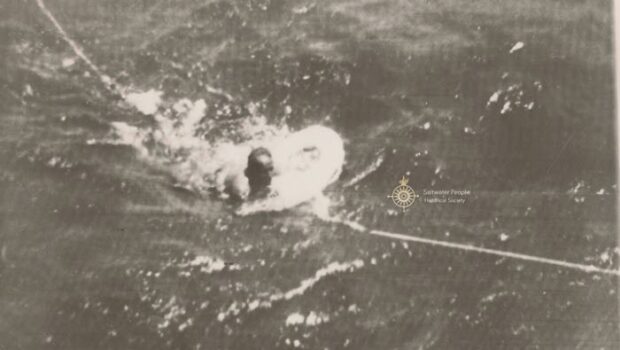Luck isn’t the best MOB recovery plan
Published on September 9th, 2024
The offshore racing safety requirements are rather onerous today with the amount of equipment and education needed. It is a significant investment for both skipper and crew, but staying alive is the mission and this story from the 1951 Transpac Race is a reminder that luck isn’t the best man overboard recovery plan:
The racing sloop L’Apache, a 73-footer, was running in second place in one of the world’s longest yacht races—from Los Angeles harbor to Honolulu. At dawn one day, L’Apache’s boom tackle broke and had to be repaired under way, with 8-foot seas running.
Precious time was wasting, so crewman Ted Sierks, 40, an ex-Marine and photographer, was braced against the rail, trying to get the fractious boom under control. And then the rail broke and Sierks slid into the sea.
A life ring with knife and flashlight attached was thrown to him, but before the crippled L’Apache could come about and work back to the spot, Sierks was out of sight in the vastness of the Pacific.
Six nearby yachts converged on the area when they heard L’Apache radio the shocking message: “Man overboard!” From Honolulu, 800 miles away, the Navy sent ships to the manhunt: an escort carrier, four destroyers, three destroyer escorts. An airrescue B-17 droned out from the Army’s Hickam Field to join in the search.
Sierks, gripping the life ring, found himself in one of the most appallingly lonely spots a man could imagine. He soon gave up hope, but found that he could not give up trying: “It’s hard to drown when you know how to swim.”
That first day, sharks pestered him and he killed one: “I grabbed his tail, flipped him over and ripped up the belly with my knife.” He had plenty of time to think. “I thought about how I was messing up the race for a lot of people. I thought about the time I had wasted in my life.” At sunrise the next morning, the sharks came back.
Aboard the destroyer escort Douglas A. Munro the captain pledged a $50 reward for the first man to spot Sierks. The Navy, which knows how long a man can last in the open sea, ordered the search ended at 2:00 pm. At 1:15 pm, two seamen sighted a bobbing blond head, lost it, then picked it up again.
Sierks’ ordeal had lasted 30 hours and 15 minutes. He would not soon forget it. “Now that I’ve been rescued, I figure there must have been a reason,” he said. “There must be something for me to do. I’ll have to try and find out what it is.”










 We’ll keep your information safe.
We’ll keep your information safe.